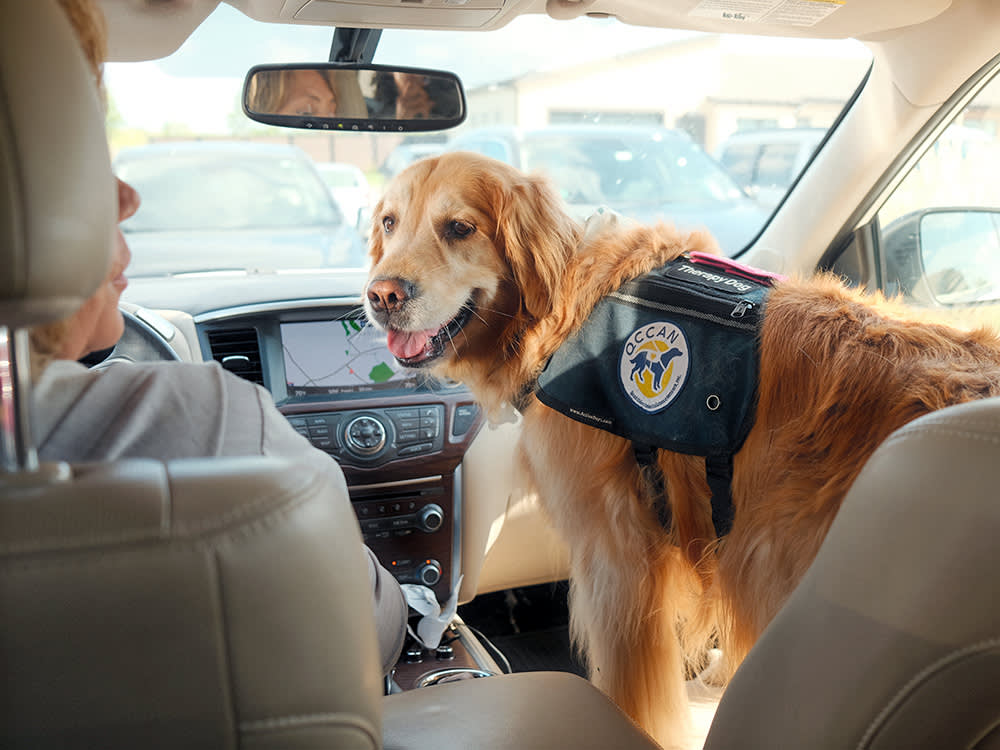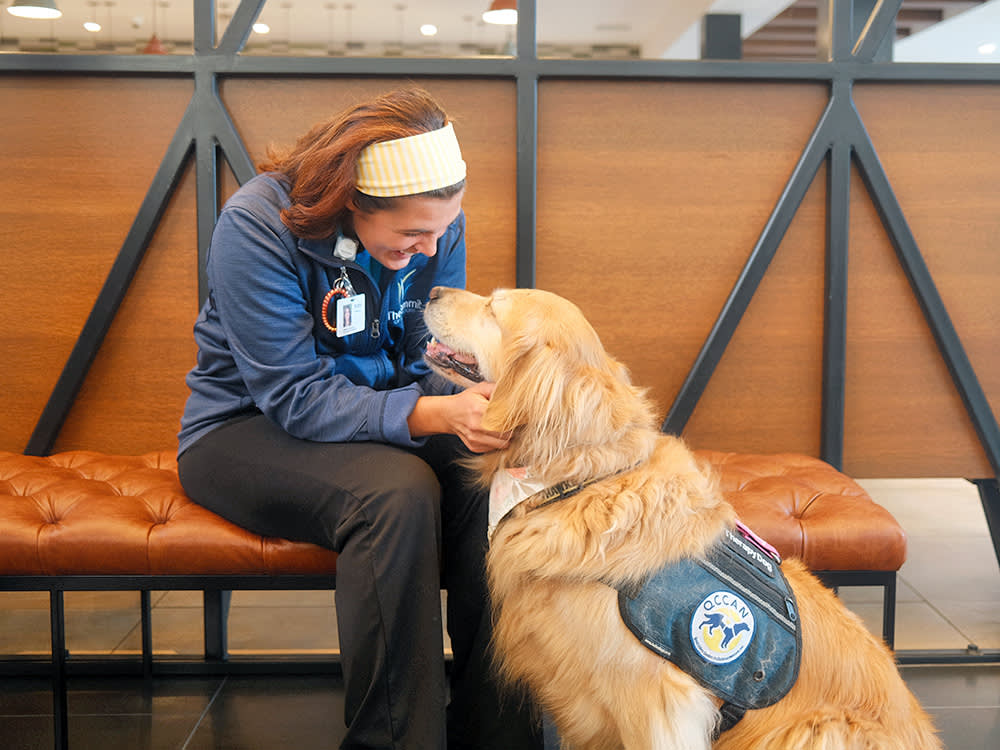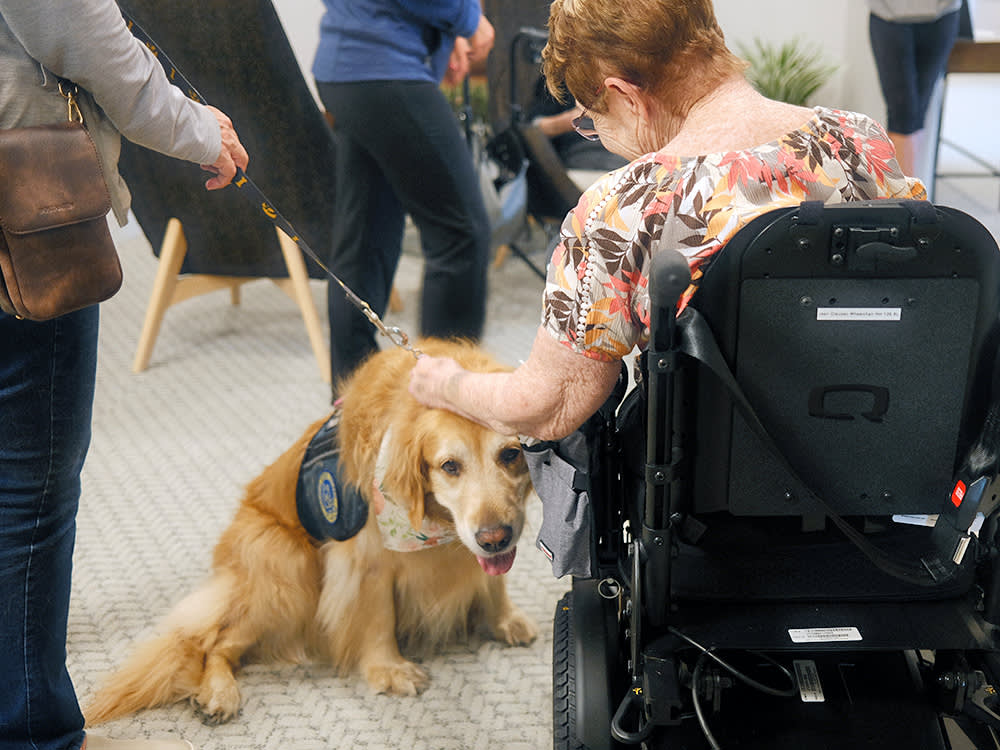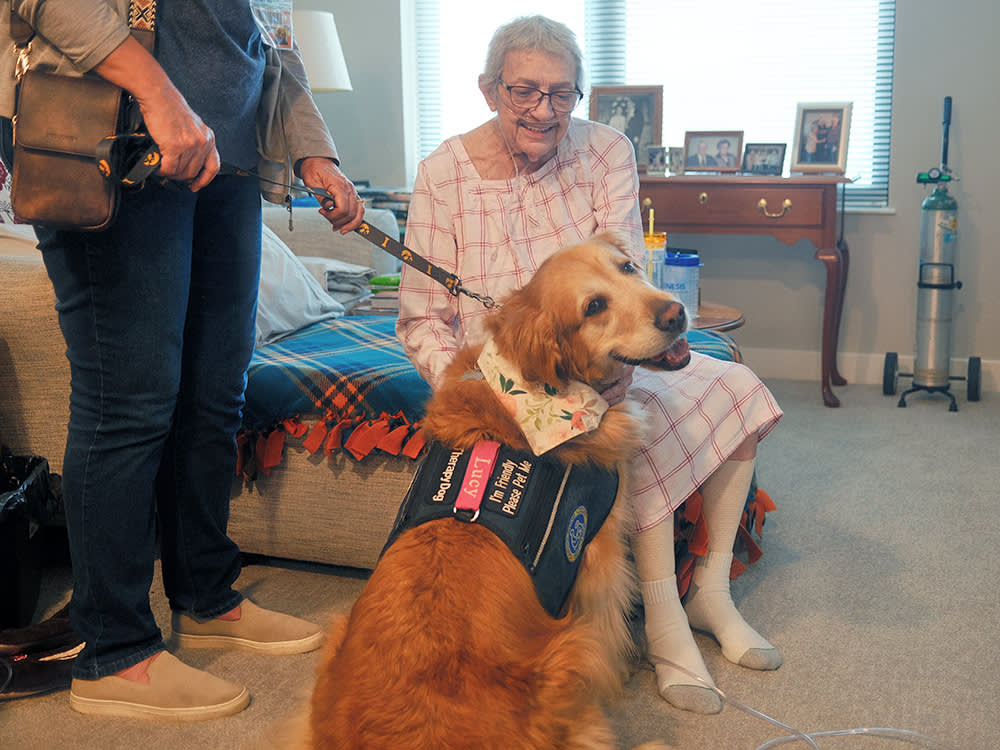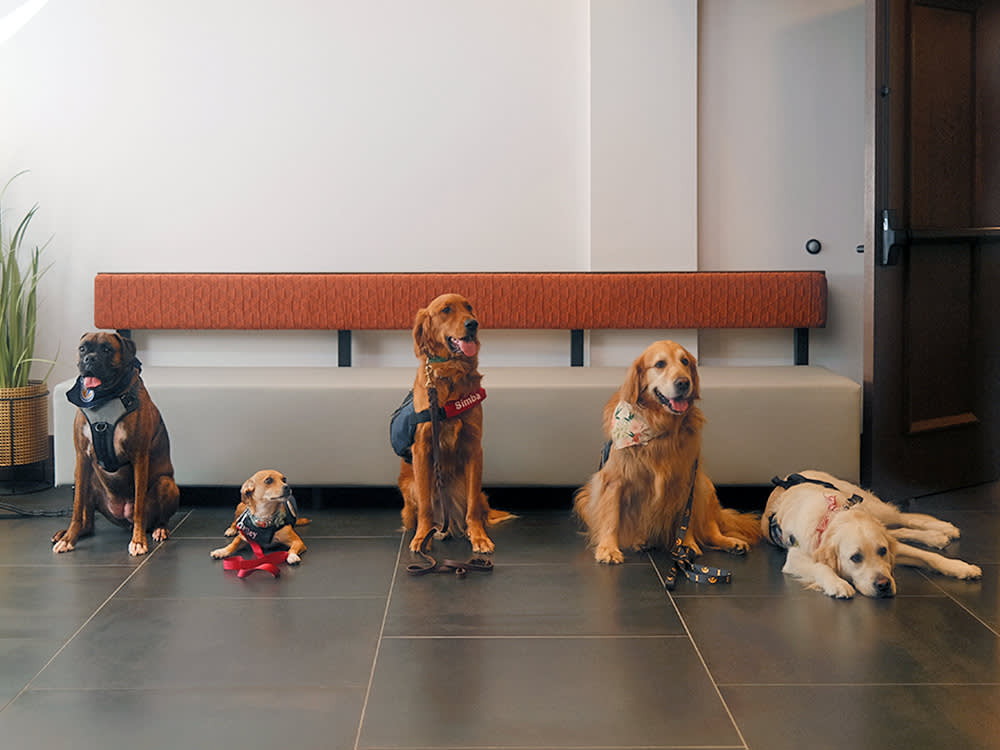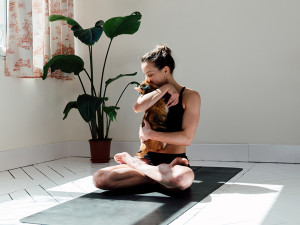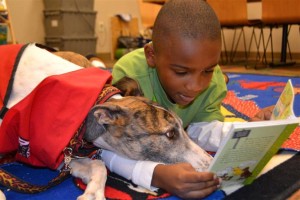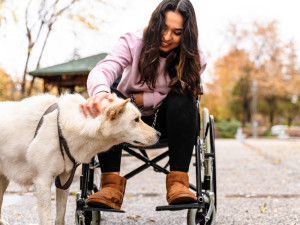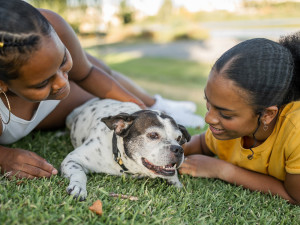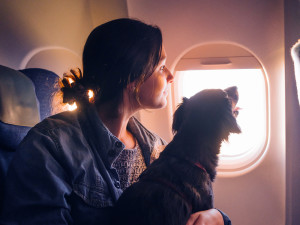I Shadowed My Family’s Therapy Dog at Work—Here’s a Peek Into Our Day
Meet Lucy, a pup who’s trained to bring joy to all who meet her.
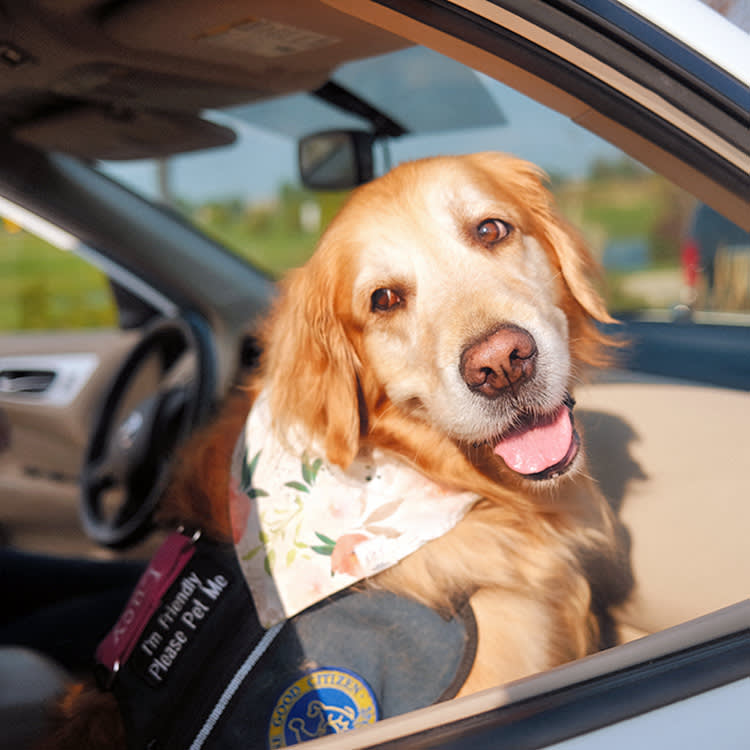
Share Article
My family’s Golden Retriever, Lucy, like many dogs, loves playing fetch, running through the park, and going for walks with my dad. She has a particular affinity for fish (put her in front of an Animal Planet TV show, and she’ll be locked in for hours). But there is one interest that makes her particularly unique: Lucy loves her job.
Lucy, who is eight years old, has been volunteering as a therapy dog since 2017 in my parents’ town of Bettendorf, Iowa. She is certified through the Quad Cities Canine Assistance Networkopens in a new tab (QCCAN), an American Kennel Club (AKC)-registered, nonprofit therapy dog organization. Founded in 2012, the group’s mission is to train “highly skilled” therapy dogs and their handlers and send them on volunteer excursions in the community.

Get (totally free) deals for food, treats, accessories, tech, and way more pet parenting must-haves.
opens in a new tabVisits coordinated by QCCAN fall into three main categories: Canines Assisting at Rest Homes (C.A.R.E.S.); Events, & School; Assisting in Crisis and Trauma Situations (A.C.T.S.); and Reading Education Alliance of Dogs (R.E.A.D.). Ellen Champion, a secretary on the board of QCCAN, started volunteering with the group in 2021 — first bringing her Irish Doodle, Finn, and later certifying her Australian Labradoodle, Oscar.
“It’s very rewarding work,” she says. “I love the feeling that you’re making a difference in someone's life just by sharing your dog with them.”
How can your dog become a therapy dog?
Requirements for therapy dogs may vary depending on which agency you want to volunteer with, but at QCCAN the main requirement is that dogs be older than one year. Dogs of any size, breed, or age can work towards certification, Champion says.
Case in point: QCCAN’s smallest volunteer is a three-pound, long-haired Chihuahua, and its largest dog is a Bernese Mountain dog mix that weighs more than 100 pounds. “It’s really based on temperament more than their size, their breed, or even their age,” Champion tells me. Therapy dogs should be friendly, patient, gentle, and at ease, even in chaotic situations — and especially with strangers.
The first step for a dog to be certified with QCCAN is passing a skills and temperament evaluation, which tests general obedience practices with an extra focus on ensuring the dog is friendly with people and other dogs. After that test is passed, the dog must take a minimum of six advanced therapy dog training classes with their handler. Then, if the pup successfully passes the Canine Good Citizen testopens in a new tab, an evaluation administered through the American Kennel Club, they are ready for their first visits.
“When we test the dogs, we do a visit simulation like a library or a school — the dogs have to stay on the ground and keep their paws to themselves when someone is petting them,” Champion says. “We simulate loud noises, kids playing with things like balls or reading to them, and wheelchairs for nursing home visits. The important thing is that they remain calm with their new person.”
But the process isn’t over yet. For an average of eight visits, the therapy dog and their handler must be accompanied by a certified QCCAN mentor, who ensures everything is going smoothly before a dog can jump in a group without a mentor attending. Through its intensive training program, QCCAN averages 30 to 40 therapy-dog visits per month and has about 60-certified therapy dog teams.
It’s important to note, Champion added, that although they go through special training, therapy dogs are still considered pets rather than a medical necessity, like a service dog. Also unlike a working dog, attention from strangers is encouraged when a therapy dog is at work (Lucy and her coworkers wear special QCCAN vests that say “pet me!”).
A day in the life
So, what is a typical day of work like for Lucy and her fellow therapy dogs? When I go to work with Lucy on a day in August, we visit The Summit, a senior living community in Bettendorf. Visits to the community are coordinated by Bobbi Malmgren, a wellness coordinator at the facility’s parent company, WellSpire.
Malmgren says that as a dog lover herself, she wanted to invite QCCAN dogs to visit the residents and provide the same joy she gets from her pets. Since 2021, six to eight dogs come once a month to spend time with Summit residents. Although the facility allows pets in some of its communities, many residents are not able to care for dogs or bring them along when they move to the campus.
“It’s a great way for our residents to still get that special interaction without having to be the sole caretaker of the dogs themselves,” Malmgren says, adding that the dogs provide unconditional love and connection, which can be especially important for residents whose families live far away.
On the way to work, Lucy likes to hold my mom’s hand while she drives. She wears her QCCAN vest so she can get in the work mindset. When we arrive at the facility on this particular day, a team of five QCCAN pups wait patiently outside to start their visit. Because they’re on the job, these dogs are trained not to interact with one another — no wrestling or playing on the clock. They sit patiently with their handlers and wait for the OK to enter the building.
After arriving, the dogs congregate in a shared lobby of the facility while Malmgren knocks on doors to let residents know they have visitors. Many happily exit their rooms to dole out pets and kisses to the crew. During visits at elder-care facilities like this one, residents will often talk to Lucy, or tell my mom — her handler — about pets they have had in the past. Some get wistful about animals they could not bring to live with them but are often thrilled to be able to have a chance to talk to someone about their beloved pets.
Not everyone is able to leave their beds or their rooms, so dogs will cycle through to visit their new friends. Many therapy dogs have their own business cards, like Sherman, an Irish Cream Golden Retriever. Malmgren says one resident in their memory-care unit collects them like Pokémon cards, looking forward to meeting new therapy dogs each month and adding to his collection. "It’s a day many residents look forward to all month,” she says.
On this visit, the dogs started in assisted living and later made their way to the memory-care facility. Lucy never tires of pets and is happy to greet each new friend. She has been trained not to jump or paw at the residents, and sat quietly at their feet. One woman holds Lucy’s face and gazes into her eyes, cooing, “She’s a pretty girl.”
As I exit the building with the crew of dogs, Malmgren tells me these are the moments that makes her proud to have coordinated such visits.
“People say music is a universal language, and I kind of think dogs are like that, too,” she says. “For residents who enjoy dogs, they get so much out of it. When you watch them looking into a dog’s eyes, you can see a conversation happening even though there aren’t words being said.”
References:
Canine Good Citizen (CGC) – American Kennel Clubopens in a new tab

Kari Paul
Kari Paul is a writer whose work has been published in the Guardian, the Wall Street Journal, and New York Magazine. She has had an endless march of more than 20 foster kittens, cats, and dogs over the last few years and always cries when they leave.
Related articles
![A woman holding a cat close to her while sitting on a yoga mat.]() opens in a new tab
opens in a new tabShockingly, Your Pet Will Enhance Your Mindfulness Practice
The next time they try to kiss your face while you’re in corpse pose, let them.
![]() opens in a new tab
opens in a new tab5 Places Where Therapy Dogs Do Their Best Work
At airports, hospitals, schools, and more, therapy dogs make things better.
![A brunette woman sitting in a wheelchair wearing a pink sweatshirt, black leggings, and brown Ugg boots petting an all white Shepherd mixed breed dog on a leash at the park outside]() opens in a new tab
opens in a new tabHow to Register Your Dog as a Service Dog
The short answer: No animal registration is required, but service dogs still need to be properly trained.
![Two Black women with curly hair laying on the grass with their senior dog laying between them]() opens in a new tab
opens in a new tabTherapy Dogs Can Help You With Your ADHD
Happy news: Pups can help support your (or your kid’s) everyday needs.
![Woman petting her small service dog.]() opens in a new tab
opens in a new tabWhat People Can and Can’t Ask You About Your Service Dog
The questions will come, so you should be prepared with answers.
![Backlit photo of a woman seated on an airplane holding her dog in her lap while they both look out of the open window.]() opens in a new tab
opens in a new tabYou Can’t Fly With Your Your ESA, But Your PSD Is Welcome on a Plane
Find out how here, including what the heck those acronyms mean.
